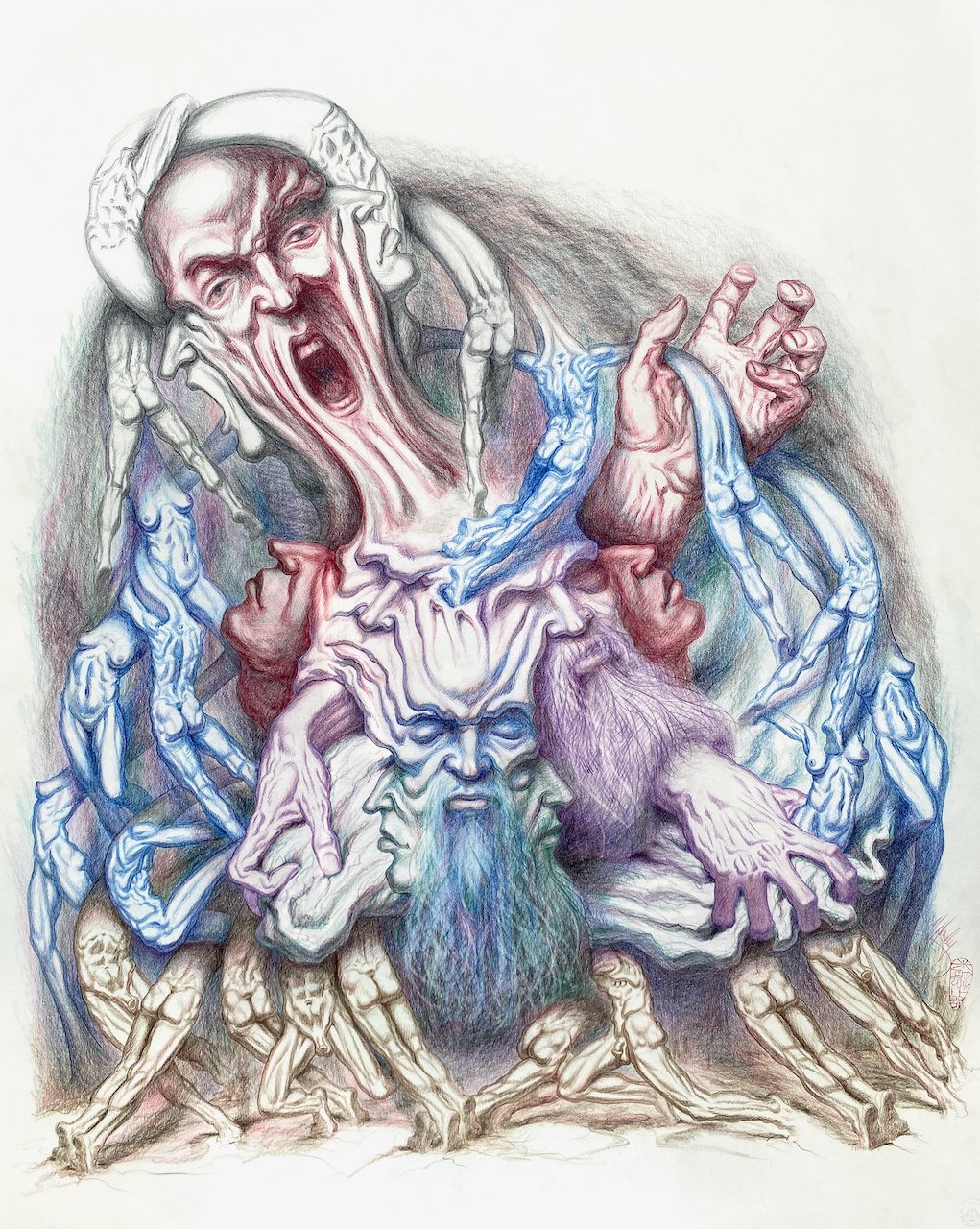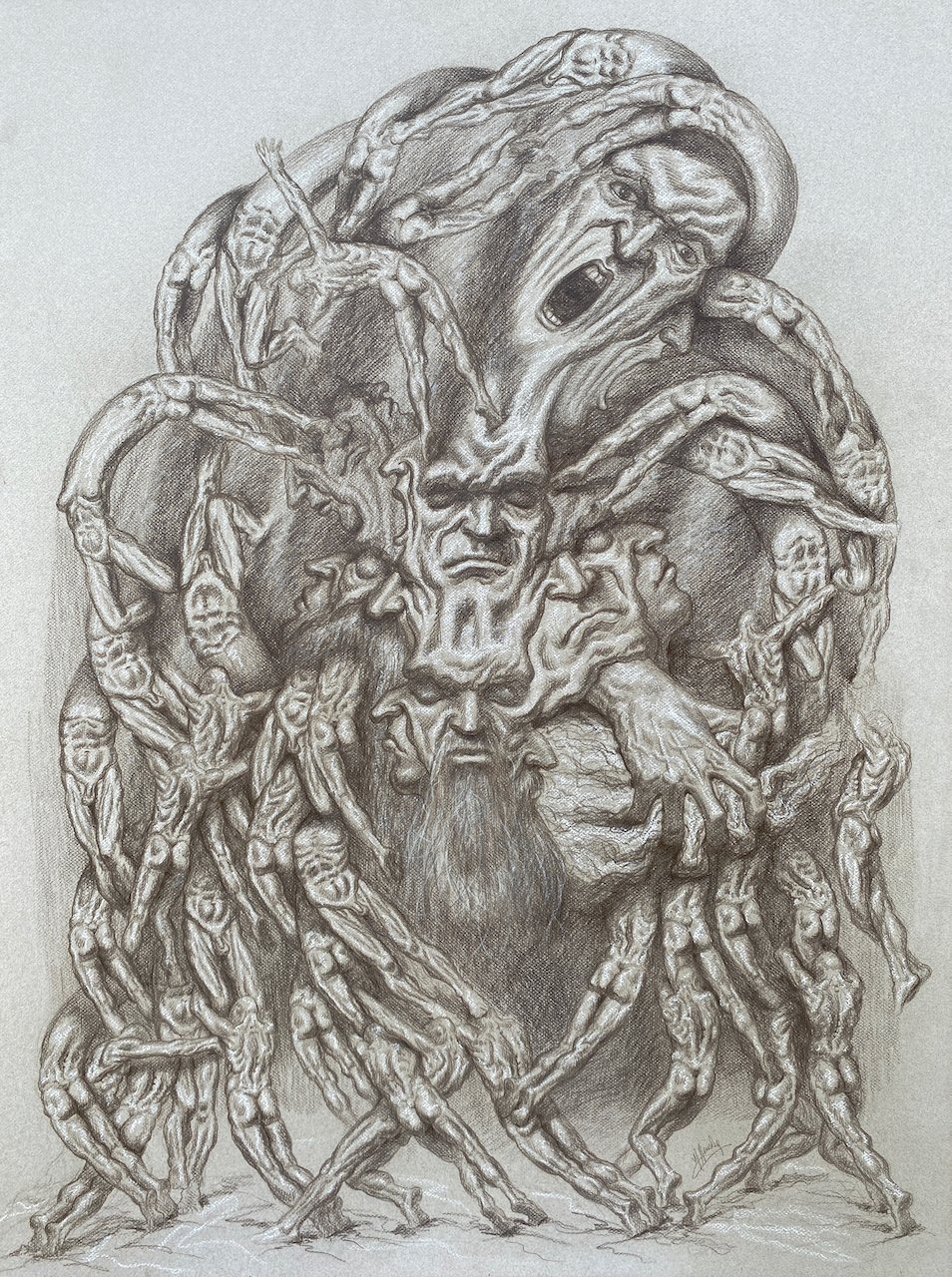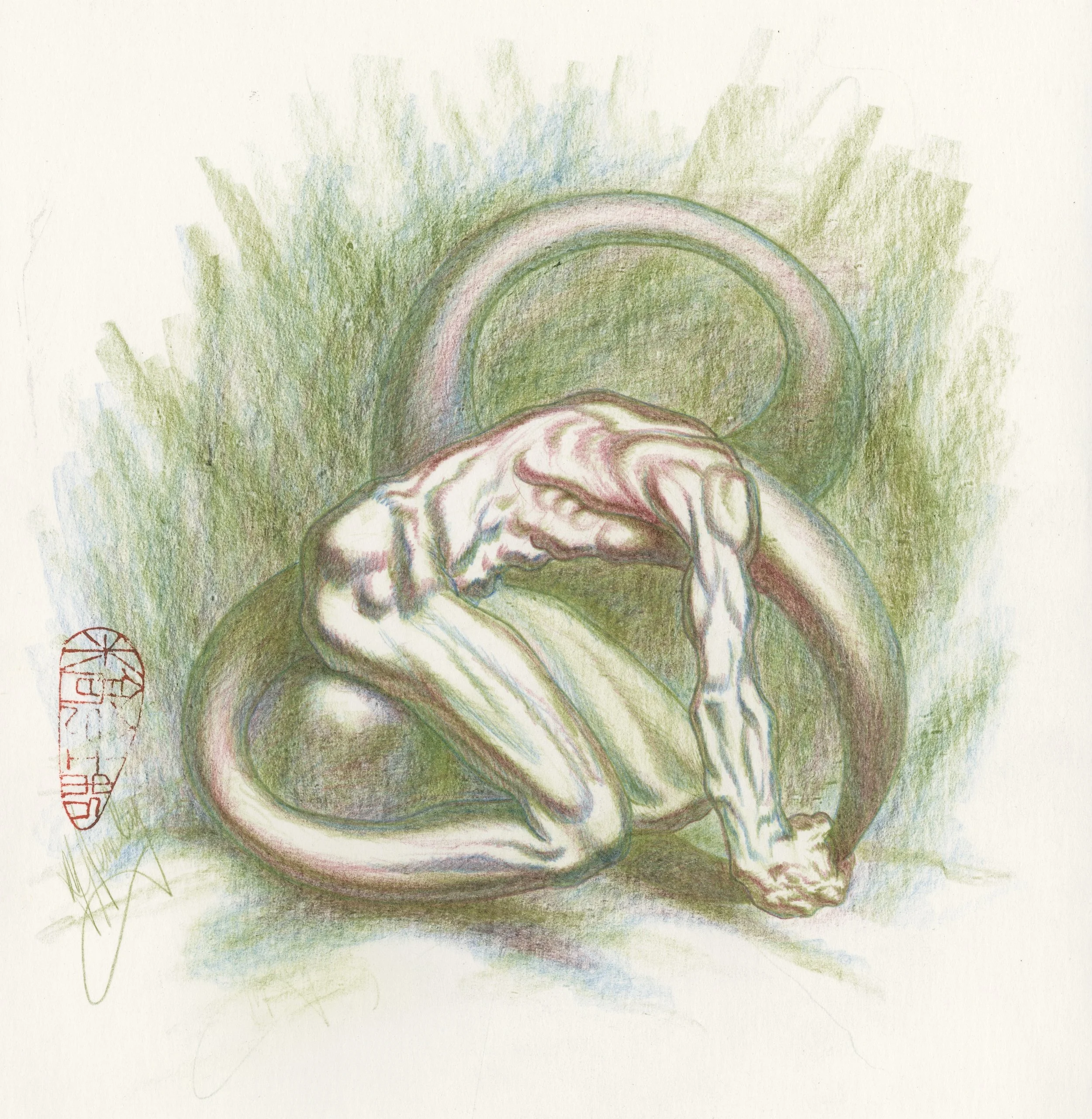Genesis: The Evolution of Humankind and the Role of the Artist as Creator
In the Genesis series, I explore the intertwined journeys of human evolution and artistic creation, both of which are characterized by transformation, struggle, and transcendence. The works in this series serve as a visual meditation on the development of humankind, both physically and intellectually, and reflect on the artist’s role as both participant in and observer of this eternal process. The drawings introduce a world not merely imagined, but deeply felt, where flesh becomes a symbol, and where form serves as a conduit for philosophical reflection.
At the center of the series stands a recurring archetypal figure: stoic, muscular, and composed, emerging from or anchored within a storm of limbs, faces, and tendrils. This central figure embodies the resilient core of humanity, a symbol of conscious awareness that remains steadfast in the face of chaos and turmoil. It is the calm within the storm, not disengaged but profoundly aware, grounded by introspection and endurance. The surrounding figures, fragmented and interwoven, reflect both the internal turmoil and external pressures that shape us. They capture the ever-present tension between order and disorder, growth and decay, identity and dissolution.
The series draws on mythic imagery and anatomical precision to convey emotional and intellectual states that defy language. Figures twist and fold into one another, creating flowing loops and complex knots of anatomical structure. These forms suggest both evolutionary entanglement and spiritual recursion, evoking the cyclical nature of life, death, and rebirth. The skeletal motifs, especially in the green-hued compositions, serve as visual mantras for mortality. Yet, they’re rendered with rhythm and grace, becoming almost serpentine, like eternal patterns from which life itself is spun.
Color also plays a symbolic role in the series. Earthy reds and purples suggest blood, raw muscle, and intense feelings; cool blues and greens evoke reflection, memory, and the cerebral. The visual tension between color zones mirrors the philosophical dualities at the core of this body of work: instinct versus intellect, chaos versus harmony, mortality versus transformation.
Throughout the series, I revisit the theme of human entanglement, exploring how we are connected through time, biology, culture, and psyche. The overlapping figures in these drawings reflect the inescapable interconnectedness of the human condition, with each figure shaped by and shaping the others. Some emerge triumphantly, while others collapse inward, echoing themes of inherited struggle, collective suffering, and generational memory. These compositions focus not on individual heroism but on collective endurance, illustrating how we carry and are carried by one another.
Yet, amidst this complexity, the central figures in Genesis remain composed. Their poise suggests a moment of clarity, not the absence of chaos, but the wisdom to stand within it without being consumed. This is the most vital message of the series: that the measure of growth is not the elimination of hardship, but the ability to navigate it with awareness and grace.
From a formal perspective, the work relies heavily on classical figure drawing and contemporary symbolism. The anatomical structures reflect years of studying artistic anatomy, bones, musculature, and weight distribution; yet, these are not merely exercises in technical rendering. Anatomy here is poetic; it is metaphor made flesh. The distortions are intentional, drawing from traditions of visionary art and expressive figuration. Elongated limbs, merged torsos, and interwoven skeletal systems serve as visual allegories for the psychic complexity of our evolution.
As an artist, I see the act of creation as a reflection of human development itself. The creative process is rarely linear; it is often tumultuous, filled with trial, error, and revelation. Like evolution, it is influenced by forces beyond our control, including emotion, memory, and hope; yet, within it, there is a driving impulse toward cohesion, meaning, and beauty. In this way, the artist becomes both a creator and a chronicler, forging new forms while also giving shape to inherited truths. The final group of drawings in the Genesis series transitions toward more circular, entwined forms, with bodies looping around themselves in nearly symmetrical configurations. These works gesture toward infinity, recursion, and self-reflection. The figures no longer struggle against their environment but merge with it. In some, the human form folds into serpent-like arcs. In others, faces are repeated in mirrored distortion, recalling both ancient myth and modern identity fragmentation. These images suggest a final stage of evolution, not the conquest of chaos but the synthesis of self with the unknown.
By titling the series "Genesis," I intentionally reference both the beginning of things and the act of, bringing forth meaning from the void. This is not a literal retelling of human origins but an imaginative examination of our emergence: how we become who we are through internal trials and external forces. It is also an acknowledgment of the artist’s role in this unfolding: to witness, shape, and reimagine. Each drawing presents an emotional architecture, an unspoken script etched in muscle, bone, and movement. While the surfaces may seem surreal or otherworldly, the underlying sentiments are deeply human: longing, fear, curiosity, love, suffering, hope. These are not just figures; they are stories. They are questions without answers, but filled with intention and reflection.
In sharing Genesis with viewers, my hope is not to provide resolution, but to create a space for resonance. A space where others may confront their own evolving identities, their own experiences of chaos and clarity. Where they may see not just images, but mirrors, distorted, perhaps, but honest.
Ultimately, Genesis is a celebration of transformation. It honors the pain and beauty of growth, the strength found in vulnerability, and the quiet power of creation. It serves as a visual testament to the resilience of the human spirit and the enduring role of the artist: to shape meaning from the shapeless, to find form in the formless, and to reflect the eternal dance between destruction and creation.









































